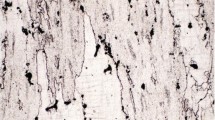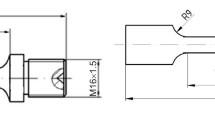Abstract
Fatigue tests in reversed torsion were run on 2024-T351 aluminum-alloy specimens in (1) uncoated state and (2) anodized with 0.3 and 0.05-mil (0.0076- and 0.0013-mm) coatings. Tests on both groups were run at low (20–25 percent), medium (55–60 percent), and high (86–91 percent) relative humidity. One lot of uncoated specimens was tested that had been polished after machining, and one lot of anodized specimens was tested that had been polished before coating. Tests on uncoated and on anodized specimens were run at stress levels of approximately 13,000, 17,000 and 20,000 psi (89.62, 117.2 and 137.9 MPa, respectively).
Results of tests on both coated and uncoated specimens showed longer fatigue life at low humidity than at high humidity. Little difference was found between tests at medium and at high humidity. No difference was found between polished and unpolished specimens.
With coated specimens, the thickness of coating showed no effect on fatigue life. Comparing the results on coated and uncoated specimens at low humidity, coated specimens had a longer fatigue life. However, at high humidity, there was no significant difference.
Similar content being viewed by others
References
Stickley, G. W., andHowell, F. M., “Effects of Anodic Coatings on the Fatigue Strength of Aluminum Alloys,”ASTM Proc.,50,735–743 (1950).
Gillig, F. J., “Study of Hard Coating for Aluminum Alloys,” WADC Tech. Rep. 53–151, P. B. 111320 (May 1953).
Wadsworth, N. J., “The Effect of Environment on Metal Fatigue,” Proc. of the Symp. on Internal Stresses and Fatigue in Metals, (1958), from Internal Stresses and Fatigue in Metals, Elsevier Publishing Co., 382–391 (1959).
Leybold, H. A., Hardrath, H. F., and Moore, R. L., “An Investigation of the Effects of Atmospheric Corrosion on the Fatigue Life of Aluminum Alloys,” NACA TN-4331 (1958).
Stickley, G. W., “Additional Studies of Effects of Anodic Coatings on the Fatigue Strength of Aluminum Alloys,”ASTM Proc.,60,577–588 (1960).
Frankel, H. E., Bennett, J. A., andHolshouser, W. L., “Effect of Oleophobic Films on Metal Fatigue,”J. of Research, National Bureau of Standards,64C (2),147–150 (April–June 1960).
Broom, T., andNicholson, A., “Atmospheric Corrosion-Fatigue of Age-Hardened Aluminum Alloys,”J. Inst. Metals,89,183–190 (Feb. 1961).
Bennett, J. A., Holshouser, W. L., and Utech, H. P., “The Importance of Environment in Fatigue Failure of Metals,” Fatigue of Aircraft Structures, Proc. of Symp. on the Fatigue of Aircraft Structures, (May 1961). Pergamon Press, Macmillan Co., 1–18 (1963).
Holshouser, W. L., andUtech, H. P., “Effect of Oleophobic Films on Fatigue Crack Propagation,”ASTM Proc.,61,749–754 (1961).
Holshouser, W. L., andBennett, J. A., “Gas Evolution From Metal Surfaces During Fatigue Stressing,”ASTM Proc.,62,683–694 (1962).
Bennett, J. A., “Effect of Reactions with the Atmosphere During Fatigue of Metals,” Sagamore Army Materials Conf., 10th Fatigue—An Interdisciplinary Approach-Proceedings, 209–227 (Aug. 1963).
Bennett, J. A., “Changes in the Influence of Atmospheric Humidity During Fatigue of an Aluminum Alloy,”J. Research, National Bureau of Standards,68C,91–100 (April–June 1964).
Hartman, A., “On the Effect of Oxygen and Water Vapor on the Propagation of Fatigue Cracks in 2024-T3 Alclad Sheet,”Int. J. Fract. Mech.,1,167–188 (Sept. 1965).
Stickley, F. W., andLyst, J. O., “Effects of Several Coatings on Fatigue Strengths of Some Wrought Aluminum Alloys,”ASTM, J. of Materials,1 (1),19–33 (Mar. 1966).
Eeles, E. G., andThurston, R. C. A., “The Relation of Humidity to the Fatigue Endurance of Aluminum Alloy,”J. Inst. Metals,95,111–115 (April 1967).
Eeles, E. G., “The Effect of Thin Anodic Oxide Films on the Fatigue Behavior of an Aluminum Alloy,”J. Inst. Metals,95,156–157 (May 1967).
Dunsby, J. A. andWiebe, W., “Effect of Atmospheric Humidity on Aircraft Structural Alloy Fatigue Life,”Materials Research and Standards,9,15–22 (Feb. 1969).
Eeles, E. G., andThurston, R. C. A., “Atmospheric and Surface Effects and the Fatigue of Aluminum Alloys,”AIAA Journal,8 (2),224–228 (Feb. 1970).
Author information
Authors and Affiliations
Rights and permissions
About this article
Cite this article
Womack, E.F., Wilson, J.H. & Mabie, H.H. Torsional fatigue tests of anodized aluminum rods. Experimental Mechanics 16, 361–368 (1976). https://doi.org/10.1007/BF02320691
Issue Date:
DOI: https://doi.org/10.1007/BF02320691




